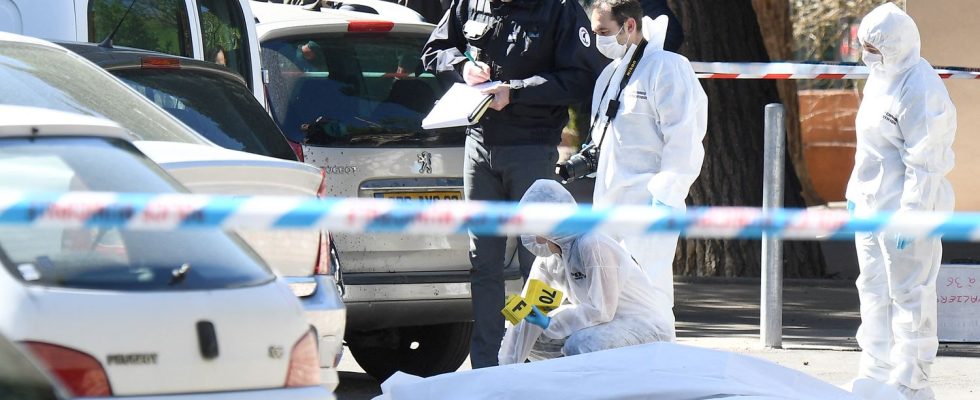Assassinations, assassination attempts between criminals and settling of scores in France increased by 38% in 2023 compared to 2022. But how can we interpret this increase? Franceinfo interviewed three sociologists specializing in the issue.
In 2023, 418 people suffered from assassinations between thugs, attempted murders between criminals and settling of scores, compared to 303 in 2022, according to the judicial police. The PJ also voluntarily distinguishes between these different acts of violence. The term “settling of scores” is a police term which refers to a fairly precise definition.
It designates an assassination between well-identified criminal groups, with a professional modus operandi, with the aim of weakening the adversary. These settling of scores strictly speaking have also increased. For last year, there were 85 compared to 67 in 2022, or 20% more. If Marseille alone has 49, it is not the only city concerned: Nantes, Grenoble, Amiens, Dijon, Valence, Besançon and even Lyon also have them.
Weapons of war
For example, last April and May, four people were killed during conflicts between criminal groups in Valence in the Drôme. The city of Dijon is also affected with two murders in four days this week. “These medium-sized cities are seeing teams from Marseille arrive to set up a market, and ensure that this market is as prolific as possible”, explains the first deputy secretary general of the Union of Internal Security Executives (SCSI). He further emphasizes that “we are dealing with delinquency which is increasingly violent”.
According to law enforcement, delinquents no longer hesitate to shoot to kill or even to terrorize the opposing camp. The use of weapons, more and more often in war, would also be uninhibited“sometimes with increasingly younger users”, observes Didier Rendu. Last year, among the 8,000 weapons seized throughout France by the police, nearly 300 were weapons of war. “We shoot for a yes or a no, with weapons of war”deplores the trade unionist who also regrets seeing “people who no longer really have any notion of human life”.
A phenomenon that is not new
So how can we understand these figures? Sociologist Anne Kletzlen, associate researcher at Mesopholis and author of the work Bandits against bandits. The settling of scores in Marseille in the 2000spublished in 2020, admits that there is “currently an explosion of this violence”. But she recalls that “this is not new”: “banditry has peaks”, she explains.
“In the 1980s, when Gaston Deferre was mayor of Marseille and Minister of the Interior, we also experienced a lot of score-settling.”
Anne Kletzlen, sociologistat franceinfo
This is confirmed by Claire Duport, sociologist and research manager at Transverscité, in Marseille. “Until 2023, there were fewer settling of scores than in 1986, when at the time there were much fewer deal points”she asserts, relying in particular on the work carried out by researcher Laurent Mucchielli. “Which obviously takes nothing away from the violence of these assassinations”she specifies.
So, can we say that the cursor of violence has moved? Are these delinquents pushing the limits of violence ever further? “The difference with previous decades is that, particularly in the South, there is a trivialized use of weapons of war”says Anne Kletzlen, confirming what the police also note. “The use of heavy weapons means that we ‘spray’. We go to a deal point and we draw from the pile”agrees Claire Duport, also recalling that certain people killed in Marseille had absolutely nothing to do with drug trafficking, but were “wrong place, wrong time”.
Younger, more violent?
Anne Kletzlen does not hesitate to speak of a rejuvenation of delinquents involved in trafficking. “Today, there is an explosion of young people. At the time, when we got into drug trafficking we arrived much later, we started with petty theft… Today, it’s easier to enter, we will even look for them: the networks recruit via social networks, and for Marseille, we even recruit outside the city”she emphasizes. “Many minors enter into trafficking, sometimes first to pay for their own consumption”she adds, evoking “a form of addiction” to violence. “Those who have seen it since childhood, it’s easier for them to get into it. For them, delinquency is even a form of recognition, it’s a bit like family,” says Anne Kletzlen.
Words that Claire Duport tempers. “Miners are not at all the majority, but it is true that in the bloody years in Marseille, we saw people in their thirties and over. Today, we see younger ones. But the testimonies collected during the work carried out on the history of trafficking clearly shows us that there have always been younger people playing small hands.. If they are not at all in the majority, “they are more visible”notes the researcher: “They’re in the street, they’re the ones getting caught.”.
It is, however, clear that “they are no longer the same worlds: IUntil the 1990s, there was a form of shift in banditry, with, for example, former robbers moving from this activity to drug trafficking. drugs”, explains Claire Duport. And to recall that drug consumption, in 20 years, has also exploded.
“Today, traffic has become much more accessible.”
Claire Duport, sociologistat franceinfo
On the question of the involvement of young people in drug trafficking and their relationship to violence, it is still difficult to distinguish what is impression and reality. Can the rejuvenation of those involved in trafficking explain the increase in the number of deaths? This is one of the questions asked by CNRS researcher Marwan Mohammed. “It looks much more amateur, younger, less supervised”he notes, evoking the hypothesis of a “Uberization of account settlements” with “less trained people who would cause more deaths”.
The sociologist notes that “the targets are much less central, we kill lookouts rather than attacking those in charge”. But Marwan Mohammed remains “very careful”planning to return to the field soon to confront this hypothesis.
